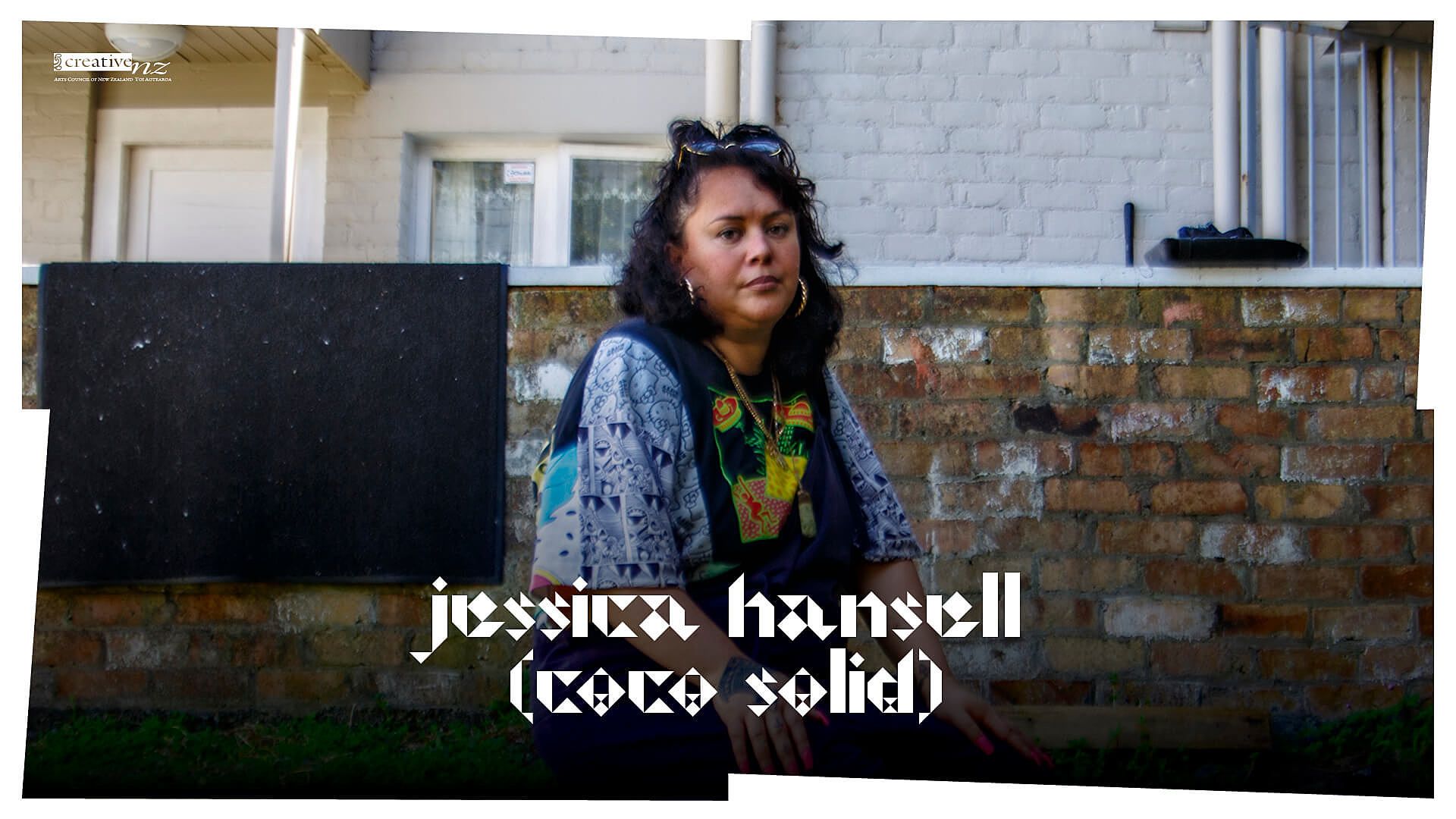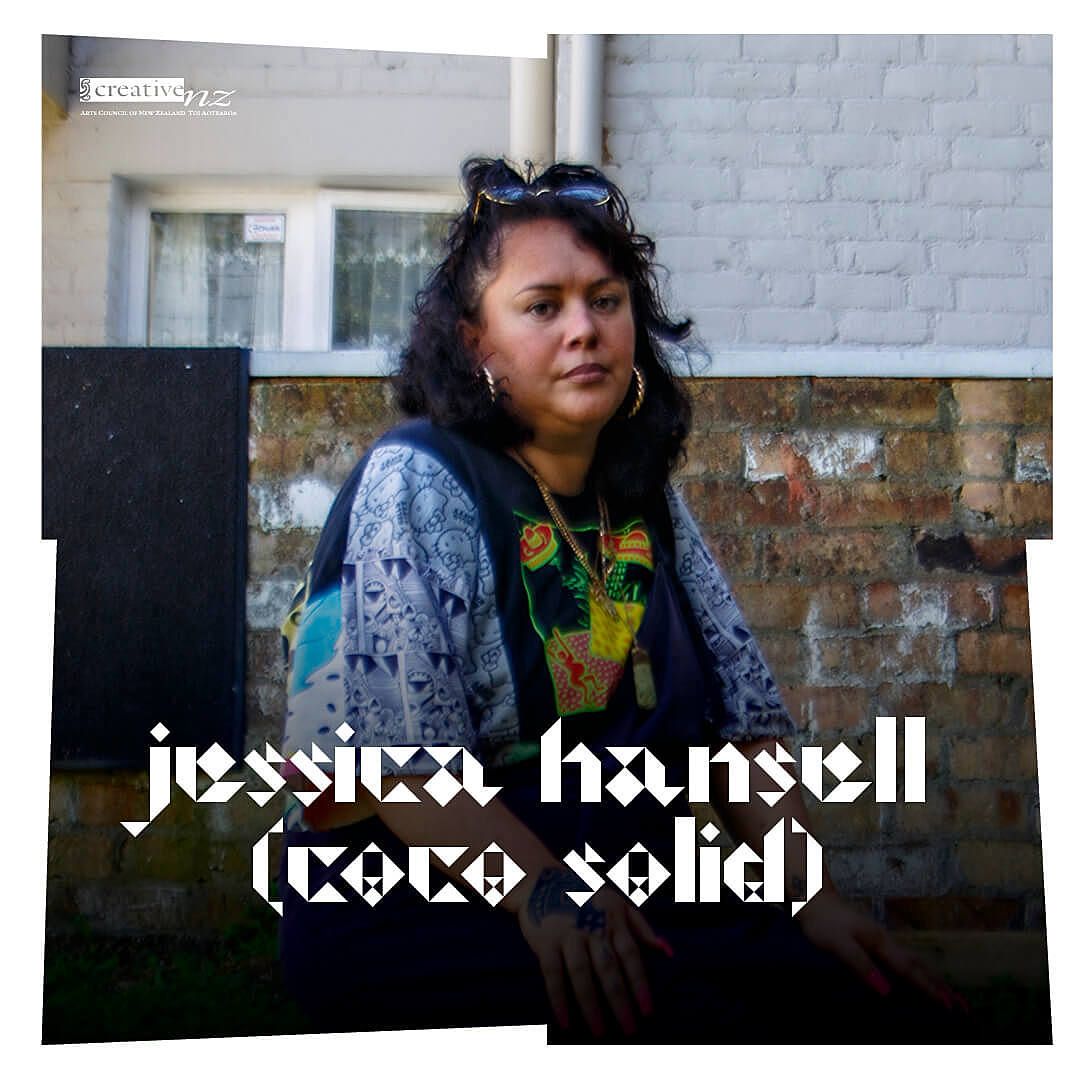On the Pretence of Legacy
You shouldn’t trust a writer to pen their own legacy, says musician, writer, director, producer and artist Jessica Hansell aka Coco Solid, who reflects on the value of stories that don’t add up.
We’re collaborating with Creative New Zealand to bring you the groundbreaking Pacific Arts Legacy Project. Curated by Lana Lopesi as project Editor-in-Chief, it’s a foundational history of Pacific arts in Aotearoa as told from the perspective of the artists who were there.
It’s hard to write a piece about legacy with a giant phallic obelisk outside your window. Upon the summit of Maungakiekie (One Tree Hill) the early European settler John Logan Campbell is theatrically buried. You can see this obelisk from most parts of Auckland, including the Manukau Heads, the Bombay Hills, much of the Hauraki Gulf and, yeah, my house. Maungakiekie was the largest Māori pā in pre-European times. The sophisticated terraced volcanic cone and its surrounding whenua are estimated to have been home to around 5000 Māori. I remember going to intermediate around here, looking up at something that was literally built to memorialise not only Campbell but also Māori, a people whom it was so gravely assumed would die out. You can imagine my preteen blinks in Ngāpuhi confusion.
The obelisk was actually an architectural structure designed by the ancient Egyptians, who called it a tekhenu. I’m not a historian or a conspiracy theorist but I do know how to fall down a ‘Why do Freemasons love Obelisks’ Quora rabbit-hole, which had me feeling like both. Apparently “the obelisk is a link to the past which symbolizes a deed which will live on in perpetuity after a human lifespan has ended”.
Hopefully my Pacific arts legacy will be that I convinced other Pacific artists not to want one.
Hopefully my Pacific arts legacy will be that I convinced other Pacific artists not to want one. I hope all that I resist, hack and disrupt will say as much as what I produce and institutionally finesse. All my favourite art legacies have the historic cohesion of a corrupted file anyway. Only after his death was it disclosed that Prince was the secret funder of a mass solar panel installation project in California. I think the best stories don’t always add up. The testimonies are allowed to be messy and a range of awkward bombshells are allowed to materialise after the fact. As an artist I identify with a vape flavour I once sampled called ‘Vaguely Cherry’. It was 1) not what it thought it was, 2) less sweet, more ‘pungent enough to be memorable’, 3) no one knew if it actually tasted good, 4) it didn’t romantically linger around long enough to get a consensus. Ever since I started creating publicly, people have contested and antagonised the value of my work. I’ve probably internalised, but learnt to transmute that chaos somewhat.
Last week I found myself at a Billy Apple talk. The esteemed artist discussed how his cells were transferred, as a living artwork, to the American Type Culture Collection in Massachusetts. He literally stored his DNA, in a modestly named project The Immortalisation of Billy Apple®. He talked about collaborating with an orchard to create his own apple, too. If I’m being honest all I knew about Billy Apple was that he was one of the financial hustlers supporting Tame Iti's legal battle while he was unjustly incarcerated for the Urewera Terror Raids of 2007 (which I actually thought was cool as hell of Apple and just as worthy of a mention). But that’s the thing with legacy, it’s highly subjective and editorial. The news outlet of the ego and the lived experience. We see this with the online passing of every pop culture legend, too. Digital justice is served with a sudden download of juicy secrets, faults, toxic traits and indiscretions. Suddenly their sanitised biography gets the depth it perhaps should have always had.
Web series 'Aroha Bridge', created by Jessica Hansell
I cook up stories and manipulate heartstrings for a living, so by reading this document you hereby agree to the snake oil sales pitch of ‘my legacy’. Under many avatars, but especially Coco Solid, I’ve been able to imagine and subsequently manifest a lot. To draw a different hand of cards to the ones you were dealt is legacy enough for some. I write, direct, make music, perform, draw, alchemise, critique, organise and cast the odd spell. I also procrastinate, sabotage, wipe-out, clap back, hide and stew in my bad moods. It’s a living, but we’ll have to see if it morphs into a legacy®.
My storytelling wasn’t born in a vacuum – my German Sāmoan grandfather had a flair for the dramatic, too. He often grabbed his heart and declared my mediocre grades ‘salubrious’ when I showed him. I was 22 when I found out salubrious was not a standard-issue compliment. If someone in my family is telling a story, exaggerations are inevitable. Embellishment is an inherited habit that I’ll always struggle to break. When your culture has survived and smuggled itself back to you through storytelling you come to understand its many capacities. I also think I may have inherited my grandfather's oratory ego, which I find both honourable and a bloody hassle.
All this is to say you shouldn’t trust a writer to pen their own legacy, not me anyway. That stuff is not for us to doctor and decide (though the obelisk sullying my skyline tries to dissuade me of that every day). True legacy lives on in the memories and, yes, the conflicting stories of others. I would say “in the hearts and minds of those we love”. But our fate can lie with those who never met us, not to mention those who wish they never had. Legacy is quite democratic in that way. It also lives on in a bloodline whenever one is brave enough to break an intergenerational curse. Now those might be my favourite artworks of all time.
All this is to say you shouldn’t trust a writer to pen their own legacy, not me anyway.
Legacy can be someone telling me that I’m the first fat, confident girl they ever saw play music live and they started wearing mini skirts after that. Success to me is looking back wondering how the hell I got the stomach to stay at the coalface of my creativity even when other miners (many men born with a silver pick-axe in their mouth) made me sit alone. I’ve found whole Facebook threads saying my mahi is overrated and even harmful for the culture, others declaring I am a “Polynesian pop samurai”. But I love the threads where no one knows who the fuck I am and they talk about the mahi the most. Making stuff without the pretence of a tidy public persona or an individualistic legacy to stressfully upkeep for me is about sovereignty. Flux. The island clock. Leaving the colonial canon and the harmful psyche that comes with it. To unpack what a legacy is, is to define what the afterlife means to humanity, and I’m not sure I can break that down in one swift essay.
While still meditating on that whole… DNA preserving thing… I was reminded of one of my favourite film characters (whom I weirdly reference often). No one asked the blood-transfused mosquito suspended in treacle in Jurassic Park if they agreed to be the founder of a dangerous dinosaur safari. But sometimes that’s (non-contrived) legacy, it’s out of your hands. You play your divine role and step aside while people assign meaning and accounts without you. I have worked in more op shops (6) than I have art galleries (0). I staunchly maintain telemarketing jobs were the best performing arts education I ever had. I couldn’t romanticise my trajectory or timeline even if I tried, which believe me I have (every time I’m forced to send someone a bio).
I’d rather shed my skin, be born again, the perpetual fool and novice.
Sometimes it all feels like an accident but that implies my mahi would have been a cosmic fluke, which it wasn’t. ‘Accidentally’ would also suggest I didn’t knowingly and tirelessly work towards an ever-deepening mystery for over half my life, until recently locked into a looping flirtation with poverty. Legacy can be complimentary but it’s also kinda… boring. It crops out the abuses and disrespect I’ve survived, the antagonists I’ve outrun, the eternal carousel of gig-economy low ballers. Upholding the pretence of a legacy never lets you disclose the HD warts of time. You can’t lament the nets you never got to cast because it’s bad for the brand of 'legacy winner'. You can never mention the sacred friendships you lost in the house fire, no one wants to see the body count or how the meat was made. The homogeny of legacy only wants the auteur news, not the weather. Many of these ghosts are universal, they stand at the bottom of every artist’s well. You get wiser but these harsh lessons never age a day, even if you (and your precious legacy) do.
I’d rather shed my skin, be born again, the perpetual fool and novice. I think some of the greatest Pacific artists and performers I’ve ever met are hidden in garages, bedrooms, making a living far removed from the art racket. They think art legacy is for the birds and maybe that’s where I get my unfrackable cynicism from.
I will say, when your people are lost at sea and need to see a flare of hope, your endurance is the win and it's a collective one
I will say, when your people are lost at sea and need to see a flare of hope, your endurance is the win and it's a collective one – not the accolade we too often project our worth upon. It's about the elevation and aspiration you can offer your global fanau as salve. Survival is something to be grateful for, but ‘doing well’ for your people is surviving in public, a garish middle finger to the various regimes that gaslight us into stopping altogether. Every time I have done well (in that sense) I am reminded the statue might be 'mine' but it stays at my mum’s, and the victory lap itself takes place in an unseen amphitheatre where the ancestors line the bleachers.
Legacy is an embalming fluid that attempts to possess and control a version of events. As a writer, I can do that with fictional lives, but to my own? Legacy is essentially pretence, which is not only a deflection of truth but an addiction, one of those ‘but I've come too far to reassess what’s real’ myths. To attempt to unstitch every stitch I sew, so as to honour a more perpetual design, is my new outlook. I hope this kaupapa plants me into the eye twinkles of the unaware young bucks and the baby-faced mes, many of whom I may never know. It’s perfectly fine if they don’t know me either.
cnz
This piece is published in collaboration with Creative New Zealand as part of the Pacific Arts Legacy Project, an initiative under Creative New Zealand’s Pacific Arts Strategy. Lana Lopesi is Editor-in-Chief of the project.
Series design by Shaun Naufahu, Alt group.
Header photo by Pati Solomona Tyrell.



